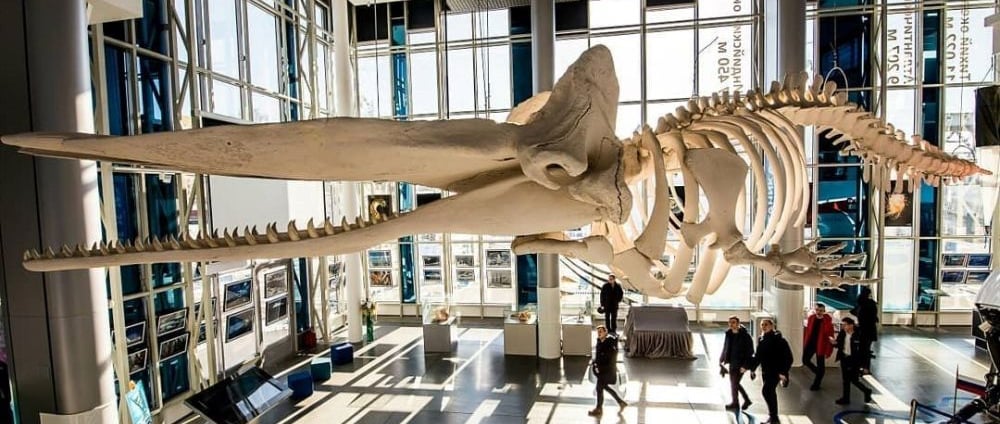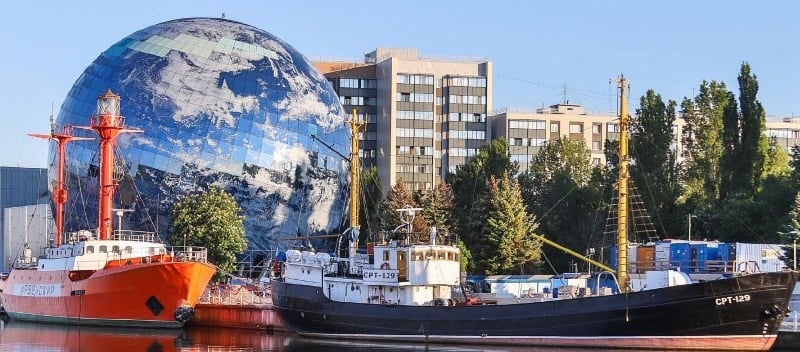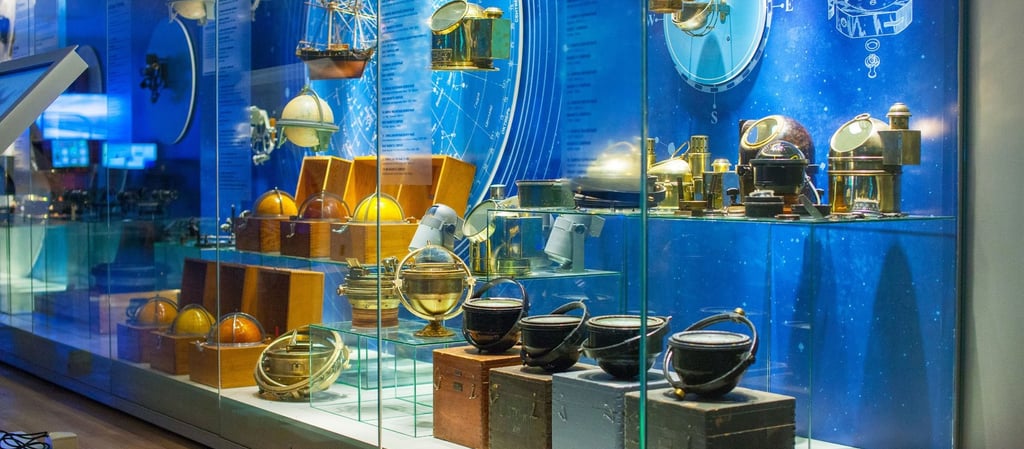Museum of the World Ocean: Russia’s Great Window to the Sea
Anchored in Kaliningrad, this expansive museum complex dives deep into maritime history, oceanography, and naval heritage across land, ship, and sea.


Where Land Meets the Infinite Blue
In Kaliningrad, the westernmost outpost of Russia, where the spires of Königsberg meet the cold embrace of the Baltic Sea, there lies a place where the ocean itself becomes a story — vast, mysterious, endlessly alive.
This is the Museum of the World Ocean, an extraordinary complex where science, history, exploration, and imagination converge in a celebration of the sea that connects all peoples.
Here, alongside the banks of the Pregolya River, amid the masts of historic ships and the gleam of modern exhibits, visitors are invited to explore the infinite expanse that begins just beyond the shore — the world ocean that shapes our planet and our future.
A Museum Born of the Sea
The Museum of the World Ocean was founded in 1990, in the turbulent twilight of the Soviet Union — a time when Russia was looking both backward and forward, questioning its place in the world.
Kaliningrad, once a Prussian port and long a closed military city, emerged as the ideal site for a new kind of museum — one that would celebrate maritime culture and knowledge in its broadest sense.
Built around the decommissioned research vessel Vityaz, the museum grew rapidly into a sprawling complex encompassing historic ships, scientific exhibits, natural history, art, and exploration.
Today, it stands not only as Russia’s premier maritime museum but as one of the most dynamic centers for oceanic science and culture in all of Europe.
The Heart of the Museum: Vityaz
The soul of the Museum of the World Ocean is the legendary R/V Vityaz, moored permanently at the museum’s quayside.
Built in 1939 and transformed into a research vessel in the postwar years, Vityaz conducted some of the most important oceanographic expeditions of the Soviet era.
Stepping aboard, visitors enter a world of scientific adventure:
The decks echo with the footfalls of explorers; the laboratories are filled with the ghosts of discoveries; the bridge looks out toward horizons once unknown.
Exhibits aboard the ship tell the story of deep-sea exploration, marine biology, hydrography, and the life of scientists at sea. One sees the instruments they used, the samples they collected, the journals where they recorded their findings — all reminders of a time when the ocean was a frontier to be charted.
Ships of Memory
Surrounding the Vityaz, the museum presents a remarkable fleet of historic vessels, each with its own story:
The submarine B-413, a Soviet-era Foxtrot-class submarine, offers visitors a rare chance to experience the cramped, tense life beneath the waves during the Cold War.
Nearby, the research vessel Kosmonavt Viktor Patsayev, still operational, served both as a space communications ship and an oceanographic platform — a testament to the strange marriage of sea and space in Soviet science.
Additional ships include historic icebreakers, fishing trawlers, and rescue boats, each evoking the rich and often perilous history of life on the sea.
Wandering this floating museum, one moves through decades of maritime innovation, from the age of sail to the electronic age — a journey through the evolving relationship between humankind and the ocean.
The Ocean Revealed
Beyond its historic ships, the Museum of the World Ocean offers world-class exhibitions on marine science, natural history, and the art of the sea.
Its modern galleries explore the vast and interconnected realms of the global ocean — from the icy polar seas to the mysterious depths of the abyssal plain.
Spectacular aquariums bring the life of the sea to vibrant presence:
Schools of shimmering fish dart through coral reefs.
Jellyfish pulse with ghostly grace.
Sharks glide silently through deep tanks.
Interactive displays invite visitors to explore ocean currents, climate systems, marine geology, and the urgent challenges of ocean conservation.
Throughout, the exhibits emphasize a profound truth: that the health of the ocean is inextricably linked to the future of life on Earth.
Practical Information
Location
Museum of the World Ocean
1 Naberezhnaya Petra Velikogo
Kaliningrad, Russia
The museum is located along the Pregolya River embankment, in the heart of Kaliningrad, within walking distance of the city center and major landmarks.
Opening Hours
Tuesday to Sunday: 10:00 – 18:00
Monday: Closed
Extended hours during the summer season and for special events.
Admission
General admission fee varies depending on exhibition package (ships, aquariums, main galleries, etc.).
Discounts for children, students, pensioners, and family groups.
Combined tickets available for multiple ships and galleries.
Special events and temporary exhibitions may have separate pricing.
Getting There
By foot: The museum is a short walk from central Kaliningrad.
By public transport: Bus and tram routes stop nearby; taxis and ride-sharing are readily available.
By car: Paid parking is available in the vicinity.
Facilities and Services
Historic ships: R/V Vityaz, submarine B-413, Viktor Patsayev, and others.
Aquariums featuring diverse marine ecosystems.
Exhibition galleries on marine science, history, and art.
Lecture halls and conference spaces.
Museum shop offering books, nautical souvenirs, and local crafts.
Café with river views, serving local and international cuisine.
Accessibility: The museum’s modern buildings are wheelchair accessible; some historic ships have limited accessibility due to original structure.
Audio guides available in Russian and English.
Guided tours can be booked in advance.
Events and Programs
Regular public lectures, scientific symposia, and film screenings.
Workshops and educational programs for children and families.
Annual World Ocean Day celebrations and environmental awareness events.
Cultural festivals highlighting the maritime traditions of the Baltic region and beyond.
Official Website
https://world-ocean.ru
Site offers comprehensive information in both Russian and English, including exhibition details, ticketing, and event calendars.


A Cultural and Scientific Beacon
The Museum of the World Ocean is more than a place of history and display — it is a living center of scientific research, education, and cultural exchange.
The museum collaborates closely with marine institutes, universities, and environmental organizations around the world. It hosts international conferences, scientific workshops, and artist residencies that bring together voices from diverse fields to address the ocean’s enduring mysteries and pressing concerns.
Its outreach programs engage students and citizens of all ages in hands-on science — from building model submarines to participating in beach cleanups and citizen science projects.
Public lectures and film screenings foster a deeper understanding of the ocean as a shared global heritage, one that demands both reverence and responsible stewardship.
The Poetry of the Sea
Perhaps what makes the Museum of the World Ocean so compelling is its recognition that the sea is not only a realm of science and industry, but also a source of poetry, art, and imagination.
Its galleries feature rotating exhibitions of maritime painting, photography, literature, and folk art that reflect humanity’s ancient fascination with the sea.
Visitors encounter everything from nautical maps of the Age of Discovery to modern underwater photography, from model ships crafted by hand to contemporary works that explore the ocean’s place in our collective psyche.
In this way, the museum speaks to both the mind and the heart — celebrating the sea as a domain of wonder and meaning, as well as one of knowledge and survival.
The Visitor’s Experience
To visit the Museum of the World Ocean is to embark on a voyage — through history, through science, through imagination.
One might begin aboard the Vityaz, feeling the creak of deck boards beneath one’s feet. Then descend into the tight metal corridors of the submarine B-413, breathing the atmosphere of a vanished era.
Later, one might drift through the aquarium halls, mesmerized by the slow dance of marine life, or stand before a storm-tossed painting of ships battling the elements.
Throughout, the experience is one of immersion and discovery — a chance to engage with the ocean as both a material reality and a timeless symbol of the human quest for meaning.




